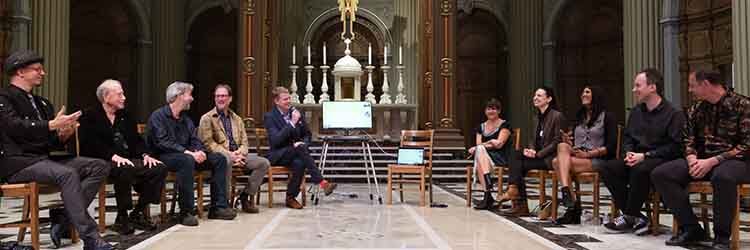April 13, 2020

Artists, astrophysicists, and neuroscientists who collaborated on art exhibits at the Manresa Gallery at St. Ignatius Church in San Francisco discuss their projects. Image by Wendy Leyden.
Sigma Xi will highlight interdisciplinary collaborations, particularly those that connect art and science, in preparation for its Annual Meeting and Student Research Conference in November, where the theme will be Hacking the Brain: The Intersection of Art and Neuroscience.
From October to December 2019, Sigma Xi was part of As Above As Below, a collection of six multimedia and interactive exhibits in San Francisco created by teams of artists, astrophysicists, and neuroscientists. Each exhibit explored the parallels between galactic and neuronal networks. The collection was curated and produced by Esther Mallouh of Keen on Art.
Some of the collaborators sat on a panel discussion, moderated by Sigma Xi Executive Director and CEO Jamie Vernon, for the exhibit opening to discuss their projects and what it was like to work together.
“I think the bottom line of this is that artists and scientists are looking for creative solutions to innovate,” said Forest Stearns, the creative innovation consultant and artist in residence founder at Google AI Quantum.
Joel Primack, Sigma Xi immediate past president and a distinguished professor of physics emeritus at the University of California, Santa Cruz, said he came away with a new perspective about his own research.
“In working with Olaf Sporns [of Indiana University Bloomington], who is one of the great experts in how the nervous system is connected, especially the brain, I learned a lot about how to analyze networks, and I hadn’t actually gone in that direction before in my own research,” Primack said.
While some artists pitched concept ideas to their scientists, artist Anastasia Victor, who designs 3D interfaces and interaction for extended reality, said her team worked together from start to finish.
“It was both a really amazing process and also incredibly challenging, I think for all of us, (a) to determine a shared language, and (b) because we have a certain degree of domain expertise,” Victor said. “Being accustomed to having a really comprehensive understanding of a space and then coming into having to negotiate that with other people was a really remarkable part of this process.”
Sigma Xi is working with Mallouh to feature some of the artistic collaborations at its meeting in Alexandria.
Sigma Xi Annual Meeting and Student Research Conference
November 5–8, 2020
Alexandria, Virginia
Conference Tracks
See: Neural and computational mechanisms of vision and their relation to visual arts, data visualization, computer-based vision, and robotic vision
Hear: Computational and experimental methodologies that investigate the brain’s response to performing, composing, or listening to music, and the use of sounds in art and communication
Move: How neuroscience and cognitive science inform artificial intelligence and robotics design, and the application of movements such as dance as a therapeutic tool for neurological disorders
Science Communication, Education, and Public Engagement: Communicating science through art; integrating arts and humanities in STEM education, evaluation strategies, and best practices
Research Enterprise and Professional Development: The integration of arts in basic and translational research, cultivating effective interdisciplinary collaborations, leadership training, science policy, publishing, mentorship, and diversity
Research Ethics: Ethical challenges facing the research community, ethics of artificial intelligence and machine learning applications, how neurotechnology may be used to affect human behavior